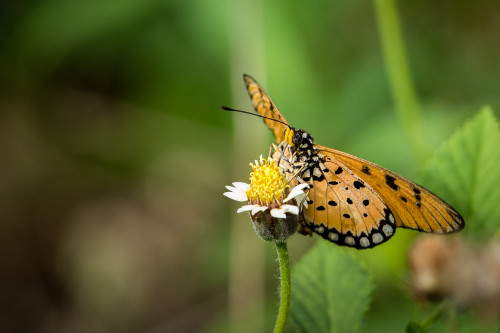
It was near dusk, when I spotted this delightful Tawny Coster butterfly (Acraea terpsicore) weakly fluttering over a patch of Tridax Daisy flowers (Tridax procumbens), popularly known as ‘Mexican Daisies’ or ‘Coat Buttons’.

Mexican daisies belong to the Sunflower family (Asteraceae ) and are quite common, all across the plains of India. Standing around 30-60 cms tall, with a rather hairy stem to boot, the leaves of the Mexican Daisy are ovate or lanceolate with toothed edges. The small creamy white flowers have five petals, which are notched on the outer edges, and possess a yellow centre.
The plant bears flowers all the year around, but blooms profusely from May to December. Commonly encountered alongside pavements and among rock and wall crevices, it’s greatly favoured by low flying butterflies and areas with a rich concentration of these flowers are also plentiful in butterfly diversity.

In order to capture the shots presented here, for your viewing pleasure, I used a Canon EOS 5D mark III, fitted with a Canon EF 300mm f/2.8 L IS USM + Canon EF 1.4X II Extender. The 300mm f/2.8 lens, without the use of an extender gives a magnification of 0.13X at a minimum focus distance (MFD) of 2.5m (8.2 feet). Extenders do not affect the Minimum Focus Distance of the lens they are mounted behind, thus the maximum magnification (MM) of the lens is also multiplied. Thus, a 1.4X Extender resulted in a magnification of 0.182x, at the same MFD. And even though it is not quite the same as having the luxury of a 1:1 ratio magnification of a dedicated macro lens, it’s still decent enough to capture some stellar close-up shots.

The Tawny Coster (Acraea terpsicore, Family Nymphalidae) is a dainty, leather winged butterfly common in grass and scrub jungles. Possessing a characterisitc weak, fluttering flight, It is generally given a wide bearth by most predators, as it possesses poisonous alkaloids in its body. The species, along with the Yellow Coster (Acraea issoria) are the only two representatives of this predominantly African tribe (Acraeini), in India.

The Butterfly derives the first half of it’s common name ‘Tawny’, owing to a predominantly yellowish brown coloration, which is derived from the Anglo-French word ‘tauné’, which translates to ‘associated with the brownish-yellow of tanned leather’, or ‘tan-colored’.
The species is widely distributed across India, through Sri Lanka and is commonly seen on the wing, year round, equally at home in forest clearings and open country, though avoiding dense undergrowth and shady areas.

Though mainly seen at low elevations, it has been recorded at heights up to 7,000 feet (2,100 m) in south India and occasionally, in the North. It is particularly abundant during the pre-monsoon and monsoon period, becoming increasingly scarce in the following months.
Male Butterflies are also known to utilize a copulatory plug or ‘sphragis’ a glandular, waxy secretion, which is passed along with the spermatophore, and which spills out of the females copulatory opening, hardening within hours of copulation, in order to prevent further matings amongst fertilized females, thereby ensuring their genes are successfully passed on, to the resulting brood.

Members of the family Loganiaceae and Passiflora species are favoured as larval host plants, many of which contain toxins that are sequestered by the larvae.
Caterpillars are cylindrical and slender, with six longitudinal rows of fine branched spines; reddish brown with an oily gloss, much paler on the head, second and last segment; overall quite ‘unwholesome’ looking, doubtlessly protected like the adult.
The Pupa is perpendicularly hung, long, slender and smooth; two lateral angles on the thorax; head quadrate; color creamy white, with broad longitudinal bars of purplish-black, spotted with orange.


Nice shots and Blog sir. I have observed that maxican daisies are one of the best flowers to photograph butterflies. They tend to sit on these flowers for a long time. Though the stem is slender and tend to oscillate, with most other flowers, they tend to fly away faster.
This month I am able to protect and help 19 Tawny Coster caterpillars to see the light. More that 40 eggs were planted on Yellow Alder/Yellow Buttercups plant’s in my small garden in Mumbai. More than 19 Tawny Coaster butterflies able to see the world.